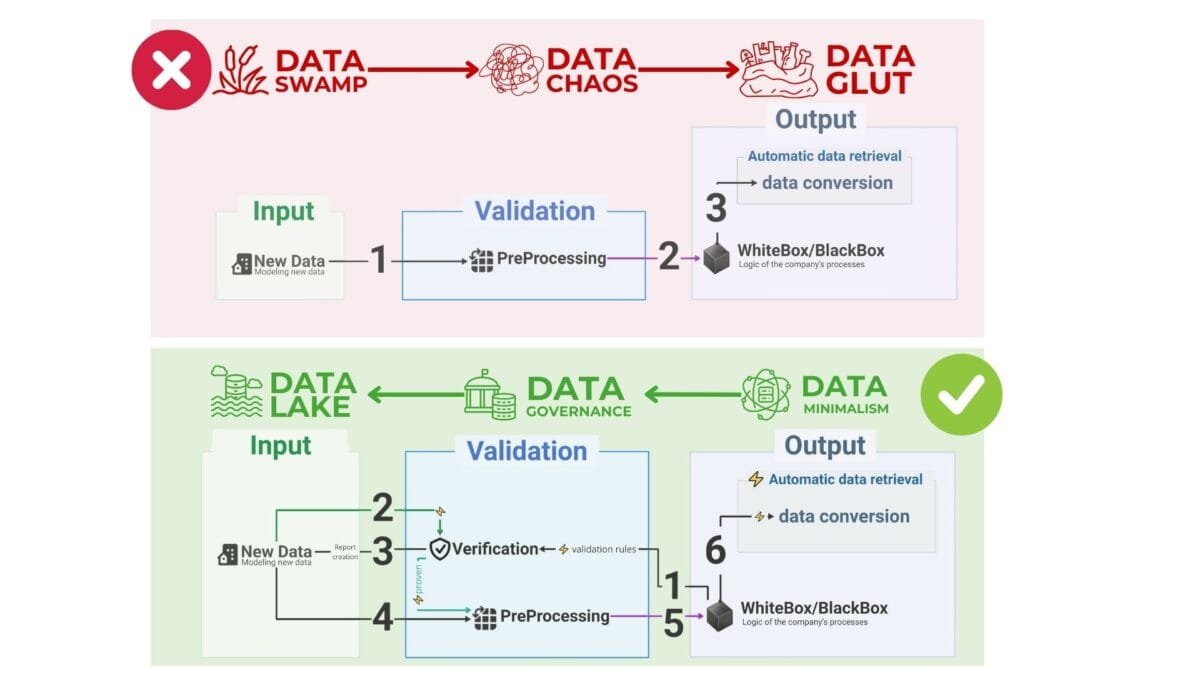Understanding and implementing the concepts of Data Governance, Data Minimalism and avoiding the creation of a Data Swamp are key to successfully managing data and ensuring its value to the business.
Data Governance is a fundamental component of data management, ensuring that data is used appropriately and effectively in all business processes. It's not just about establishing rules and procedures, but also about ensuring that data is accessible, reliable and secure:
- Definition and classification of data: Clearly defining and classifying entities allows organizations to understand what entities are needed in the company and determine how they should be used.
- Rights of access and governance: Establishing policies and procedures for accessing and managing data ensures that only authorized users can access certain data.
- Securing data from external threats: Securing data from external threats is a key aspect of Data Governance. This includes not only technical measures, but also training employees on the basics of information security.

Some of the key aspects of data management are Data Governance and Data Minimalism
Data Minimalism is an approach to reduce data to the most valuable and relevant in attribute formation, thereby reducing costs and improving data efficiency:
- Simplifying the Decision-Making Process: Reducing the number of entities and their attributes to the most relevant ones simplifies decision making by reducing the time and resources required to analyze and process data.
- Focusing on the Important: Selecting the most relevant entities and attributes allows you to focus on the information that really matters to the business, eliminating noise and unnecessary data.
- Efficient Resource Allocation: Minimizing data allows to allocate resources more efficiently, reducing data storage and processing costs and improving data quality and security.
The logical sequence of working with data should begin not just with the creation of data, but with an understanding of the usage scenarios that will create the minimum requirements for attributes and their boundary values, which in turn are the basis for creating the necessary entities.

To prevent a data warehouse from becoming a quagmire, the data creation process should begin by gathering the necessary requirements for attributes and their boundary values
In the traditional business processes of construction companies, data processing increasingly looks like dumping data into a swamp, where first data is created and then specialists try to integrate it into other systems and tools.
Data Swamp is the result of uncontrolled data collection and storage without proper organisation, structuring and management, making data unstructured, difficult to use and of low value. How to prevent lakes of information from turning into swamps:
- Data structure management: Ensuring data is structured and classified helps prevent Data Swamp by making data organized and easily accessible.
- Data understanding and interpretation: Clearly describing the origin of data, its modifications and meanings ensures that the data is understood and interpreted correctly.
- Maintaining data quality: Regular maintenance and cleansing of data helps maintain its quality, relevance and value to analytical and business processes.
By integrating the principles of Data Governance and Data Minimalism, and actively preventing data from becoming a Data Swamp, organisations can maximize the potential of their data.
Understanding and applying these concepts helps organisations to streamline their data, ensuring its security, quality and value, which in turn contributes to better decision making and overall success in a dynamic business landscape.
The symbiotic combination of data storage, processing and management opens new horizons for companies to extract valuable insights from Big Data, allowing them not just to accumulate information, but to actively use it for strategic planning and improving the efficiency of business processes.

















